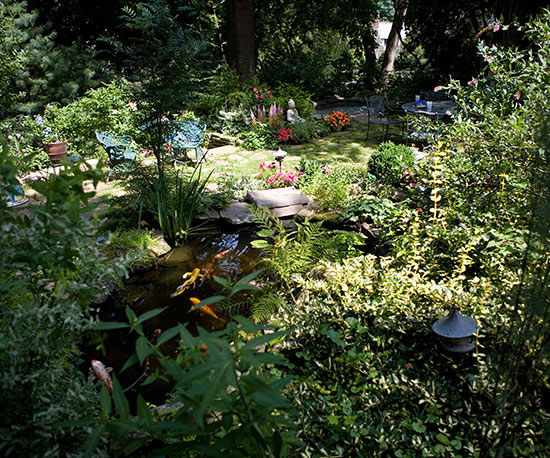






One of the biggest influences in choosing plants you'll grow is how much sunlight your garden site receives. The majority of plants thrive in six hours of sun, but thanks to the many plants that unfurl fabulous foliage and beautiful blooms in less light, you can plan a striking garden even in shady conditions.
continue reading belowGauge how much sunlight bathes your garden site. It's best to assess light patterns every hour or two in the course of a day, noting where shadows fall, linger, and pass. If you spy sunlight trails during spring, bare-branched trees often give the illusion of sunny spots beneath; what you think is a sunny area might be swallowed by shade when leaves emerge. Buildings and walls also cast shadows; consider those structures as you plot the sun's path.
Use marking flags and spray paint to indicate light and shadow in your yard, or create a light map on paper. Start with a few sheets of tracing paper, sketching a copy of your yard's outline on each page. About two hours after sunrise, observe where light and shade fall and mark them on the tracing paper, noting the time. Repeat the process through the day, each time using a different sheet of paper. Stop recording about an hour before dusk. Use a pencil to mark shady sections of the yard on each page. Label sun and shade pockets to indicate whether they reflect morning or afternoon conditions. Layer the pages together, and you'll get an accurate picture of how much light your yard receives. Create a composite drawing to use as a one-page light map.
Once you know your garden site's sun and shade characteristics, start choosing plants. A plant's light needs are more fluid than static. For instance, if you plant a sun-loving plant in a shade-dappled spot, you won't necessarily kill it. You'll likely experience fewer flowers, shorter life span, less color, or gangly stems.
A plant's light requirements shift throughout the United States. In the South, sun-loving plants might need shade during the hottest part of the day, while in the Pacific Northwest, cloud cover can prevent sun-lovers from flourishing. Where cool, wet summers prevail, plants that nominally prefer partial shade can thrive in sunnier conditions.
Understanding sunlight is simple: A plant receives sun or it does not. The intensity of sunlight varies based on time of day, with morning light offering softer, gentler rays and afternoon sun blazing with sizzling rays.
Shade presents a more complex scenario, full of nuances and degrees. There's the deep shade you find on the north side of a house; alongside a stone wall or privacy fence; or beneath a 70-year-old beech tree, where the sun only peeps from winter through early spring. Dappled shade dances beneath honeylocust trees, where small leaves filter sunlight to cast a filmy, shifting glow.
Deciduous trees offer seasonal shade. Spring sunlight under leafless boughs provides the perfect footing for ephemeral plants, such as bleeding heart or wood anemone, which stage an early-season flower show and then quietly disappear as leaves emerge and shade deepens. As the sun heads north for summer in the Northern hemisphere, shade patterns shift and shorten, then silently lengthen as summer slips into fall. Observe seasonal light patterns as you choose and situate plants for your garden.
Note: In a woodland setting, tall trees often cast light shade punctuated by shafts of sunlight. Count on reliable shade performers such as astilbe to brighten shady gardens with colorful blossom spires. Plant a mix of astilbe that bloom at different points in the season to create a longlasting flower show. Planting companions for astilbe include golden hakonegrass, goatsbeard, and other ferns.
You can make some shade do a disappearing act. If you have a tree with branches that cast dense shade, lighten the scenery below by removing lower limbs. This process, called limbing up, effectively lifts a canopy, permitting sunlight to penetrate the leafy shade. During late summer and fall, sunlight can slant beneath limbed-up trees to lighten deep shade. Selectively thinning can increase light to the ground below. Consider replacing solid fences with vine-covered lattice to increase light.
Dry shade under mature trees is one of a garden's toughest conditions, but perennials can splash color into these droughty, dark areas. For plants to thrive until they're established, they'll need frequent watering. Plants will deliver a modest flower show that slowly increases over time.
Plants for dry shade:
As you read about specific plants, you'll encounter growing requirements. Light needs are often expressed as full sun, part sun, part shade, or full shade. These terms refer to the sunlight a plant needs to yield top-notch performance. Unsure what these terms mean? You're not alone. Here's how todecipher the light code.
Copyright © www.100flowers.win Botanic Garden All Rights Reserved